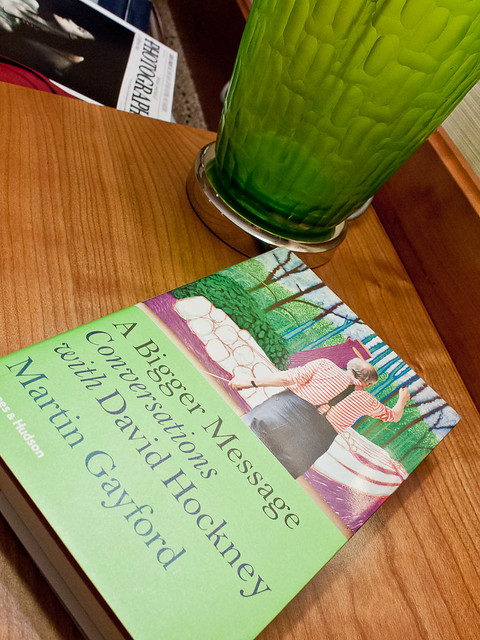
Martin Gayford is an art critic and, on the basis of this book, appears to be quite a close friend of David Hockney’s. In this book he has captured a series of conversations with Hockney about many different aspects of art – including photography. I picked it up because I’ve had an interest in Hockney’s stuff since seeing ‘Bigger Trees near Warter’ at the art museum in York about a year ago.
The subjects range quite widely, and the book is going to bear multiple readings. Hockney is extremely articulate and clearly very well informed about the history and philosophy of art in general – and he has some very interesting views about photography in particular. For example: “We live in an age when vast numbers of images are made that do not claim to be art. They claim something much more dubious. They claim to be reality.” and “I’ve always assumed that the photograph is nearly right, but that little bit by which it misses makes it miss by a mile.”
A key theme is perspective and the creation of space in images. He clearly feels that the single point perspective of a camera does not do this very effectively – his collages of the late ‘70s/early ‘80s are a testament to his experiments with this – he regards them as more akin to drawing than photography because they do not restrict the artist to a single viewpoint. On a related note his ‘non-panorama’ of 25 trees which he has joined using painting/drawing techniques reflects his take on scrolls as a stationary movie, and there is an interesting section on the use of isometric (rather than vanishing point) perspective in Chinese scrolls. He feels that it’s not possible to take a good photo of the Grand Canyon because you lose the sense of space – it might be interesting to review some of Ansel Adam’s shots with this thought in mind.
Another key theme is the importance of seeing, rather than just looking , in art. Chunks of this were about draughtsmanship and the benefit of painting from memory after properly studying a subject.
On a more philosophical bent, there were interesting discussions on photography and their perception as reality – which they aren’t. As he observed – this is not an issue for painting.
There’s lots more – he has some interesting views, with solid, if circumstantial evidence, on the use of pinhole cameras/camera obscura in Renaissance art, based in part on the odd perspectives we find in some of these images.
He also has an interesting chapter or two on using the i-phone/i-pad for drawing. In particular , because it is always with him it provides opportunities for quick ‘paintings’ of almost anything – his feet, an ashtray, his cap, whatever takes his fancy. He feels this to be a new development – although I can see some parallels with small cameras and photo-a-day.
Some of these discussions are cut down versions of some of the stuff in Sontag, and to a lesser extent, Barthes, but to me they have the real advantage that they are discussed in the light of experience.
All in all I can’t recommend this book highly enough. I suspect it will be a regular colleague as I move on to Landscape 2.
No comments:
Post a Comment